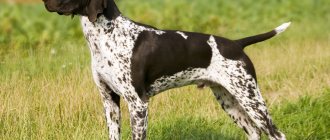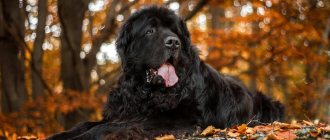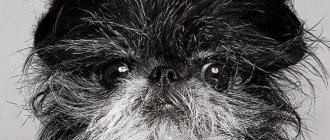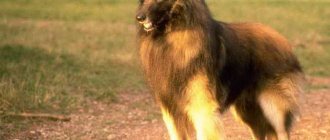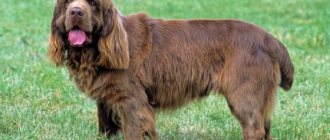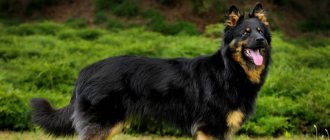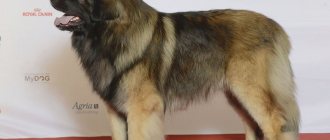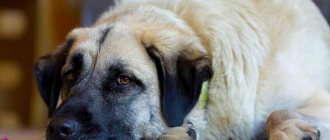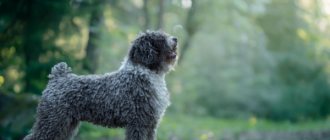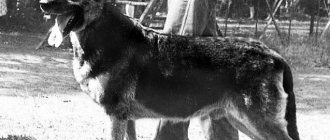Breed characteristics
| Short description | |
| Origin: | North America |
| Conditions of detention: | In an enclosure, in a house with a spacious enclosed yard |
| Purpose: | Shepherd, service dog |
| Color: | Four types - sable and white, black and white, tricolor of black, white and red, black and red tan |
| Wool length: | Average |
| Adult dog size: | Height of females – 46–56 cm, males – 48–58 cm, weight of females 18–23 kg, males – 20–27 kg |
| Average life expectancy: | 12 – 15 years |
| Walk: | Daily, lasting more than an hour, with active physical activity |
| Physical activity needs: | High demands for long-term physical activity, more than 3 hours per day |
| Fédération Cynologique Internationale (FIC) classification: | Group 1: herding and cattle dogs, Section 1: shepherd dogs |
| Puppy price: | Puppies with a pedigree from 25,000 to 30,000 rubles. |
Appearance
The English Shepherd is a strong, hardy, medium-sized dog with well-developed muscles. Sexual dimorphism is moderately expressed. Height at withers 41-58 cm, weight ― 18-28 kg.
The head is of medium length with a moderate stop, wide between the ears, slightly rounded. The muzzle is moderately wide, long, tapering towards the nose and is black (weak pigmentation is allowed in sable-colored dogs). The eyes are brown, round, medium size. Must express strong character and intelligence. The ears are set wide apart from the base, rising upward and then falling with a sharp and arching angle, lying close to the head. When excited, they rise slightly. Ideally, the ears should be 3/4 folded, although some representatives of the breed may have completely floppy ears, erect ears, or ears with different placements.
The neck is strong and arched. Stretched case. The body type is similar to other collie type dogs, but they have a stronger body and legs. The Shepherd should look athletic and muscular, but not stocky. The tail is moderately long. Back with a soft curve.
The coat is of medium length and texture, straight, wavy or curly with undercoat. Must be resistant to dirt and weather. Heavy shedding occurs in the off-season. On the head, ears, and front of the legs, the hair is short and smooth. Forms feathering on the back of the front and hind legs. The tail is very well bushed. On the neck the fur forms a heavy mane. The standard identifies 4 predominant color models:
- Black and Tan;
- Tri-color (black, brown, white);
- Black and white;
- Sable (can appear in all shades of brown from pale honey to deep red, the ends of the hair are often colored black).
History of the origin of the species
There is a legend that the ancestors of the English Shepherd came to Europe along with Roman legionnaires. The dogs herded the herds necessary to feed the army of Julius Caesar. During one of the campaigns, some of the animals remained on the territory of the British Isles. Since those times, their appearance has changed little. Over the course of several centuries, shepherds crossed with collies and other herding dogs. This is how the formation of a new breed took place.
At the end of the 19th century, its representatives arrived on the North American continent . Farmers appreciated their working qualities. And the breeders crossed the imported dogs with border collies and got hardy, hardworking dogs capable of herding huge herds without human control. The official breed standard was approved in 1934.
Character
The English Shepherd is balanced and hard-working with a friendly temperament and strong territorial and guarding instincts. Sheepdogs are very vigilant, but are often not aggressive enough to be good guards. They may growl and bark, but rarely go on the offensive. They are often wary of strangers; in the absence of aggression on their part, they willingly replace anger with mercy, and joyfully greet guests and friends of the owner. They get along very well with children of different ages; they treat the child with care and concern. Form close bonds with all family members. Some dogs try to bite their ankles when playing with children. This is instinctive behavior, which is not a sign of aggression, but only an attempt to “herd” the child.
The English Shepherd is capable of working with various types of animals, from poultry to cattle and horses.
English Shepherds are noted to have a hunting instinct. They love to drive small animals, squirrels, martens, possums into trees, and the neighbor’s cat may also play this role. Animals that are not very agile and fast can be strangled by a dog. With good upbringing and socialization, the English Shepherd gets along well with other dogs and may prefer playing with its brothers on walks. Frivolous skirmishes for leadership may arise between cables. They get along well with domestic cats with whom the dog grew up together.
The Cattle Dog enjoys working in partnership with its owner, but also performs well with a minimum of direction. Self-confidence, determination and the desire to follow the rules forces the shepherd to maintain order in its environment.
Distinctive features
English Shepherds are well-proportioned, medium-sized dogs. The main features that distinguish dogs of the English Shepherd breed:
- The body is massive and powerful, slightly stretched. The belly continues the line of the chest, does not sag and does not create the impression of being lean.
- The chest is not wide, like most hardy animals, slightly drooping.
- The head is medium in size, chiseled, tapering towards the nose. The length of the skull corresponds to the length of the muzzle. The brow ridges are not protruding, the cheeks are muscular, the lips are tightly closed.
- The eyes are not set too close or too far and are almond-shaped. Their color is dark brown. The look is distinguished by intelligence and liveliness.
- The ears are triangular, bending, and set high.
- The jaws are well developed, with strong white teeth. Scissor bite.
- The forelimbs are long, muscular, strong, and well developed. The pads on the paws fit tightly to each other.
- The hind limbs are long and powerful. The hock joint is not pronounced.
- The tail is of medium length and firmly set. The dog keeps it hanging. The tip of the tail is curved.
- The coat is medium in length. The coat is straight, shiny, thick.
Advantages and disadvantages
Pros:
- calm and balanced;
- agile and agile;
- smart and quick-witted;
- wonderful watchmen;
- excellent guards;
- suspicious of strangers;
- child friendly.
Cons: the owners did not find any shortcomings in English shepherds and characterize them only positively.
Despite the abundance of advantages and the absence of disadvantages, the English Shepherd breed is not very popular, why do you think?
Photo of an adult dog
How to choose the right puppy
English Shepherds are very smart and easy to train.
Before choosing a puppy, it would be best to study the relevant literature, talk with experienced breeders, and go to an exhibition. If you want to purchase a purebred shepherd, then you need to buy it through a club or a specialized kennel, and not on the market. If the purity of the breed is violated, then there is no hope for a professional career.
To choose a healthy puppy, you need to consider several important factors:
the baby's coat should be smooth and shiny; puppy - active and eating well; the smell of wool is pleasant; Pay attention to the puppy's parents; the documents must indicate the degree of relationship - too close is an undesirable factor, as there may be risks of genetic abnormalities.
English Shepherd color deep black and white
Photos of puppies
Nicknames and names
If the dog was purchased from a kennel, it is accompanied by a package of documents, including the puppy - a birth certificate. The registration document must include the puppy's name, information about the parents and their pedigree numbers. The veterinary passport contains information about the puppy's vaccination.
But in addition to the official nickname, you can give the dog a pet name. It will not appear either at the exhibition or in other documentation in the name of the dog, but no one disputes the right to assign a pet name.
You can use the Internet, or the history of Britain with many sonorous names known throughout the world. This could be the name of a fantasy or historical hero, a television idol. The main thing is that it is consonant, easy to pronounce and the dog likes it.
Features of character and behavior
Advantages
- English Shepherds are an example of a calm and balanced character , which is combined with the mobility and agility of the animal. Mental acuity and quick wits make it possible to make decisions independently.
- I consider shepherds to be excellent watchdogs. Dogs, infinitely loyal and attached to their owners, are capable of tirelessly performing security duty. They behave tensely towards strangers, may greet them with loud barking, and try to constantly control them. In a dangerous situation, they neutralize the offender, and if he commits aggressive actions, they can bite.
- At the same time, English Shepherds are good nannies . Dogs treat children very kindly, show affection and patience, and do not allow themselves to demonstrate aggression towards children.
- Agile and hardy, English Shepherds are dogs for people who lead an active lifestyle and go in for sports. Pets are happy to accompany their owners on hikes and take part in frisbee, agility, and flyball competitions.
A distinctive feature of the breed is the ability of its representatives to climb trees like large cats. They can hunt birds and even squirrels.
Flaws
Owners of English Shepherds characterize their pets exclusively on the positive side. These animals have no character or behavioral defects. Even if a stranger or a stranger offers a dog delicious food, it can only take it with the owner’s permission.
What is the character of the English Shepherd
The animal of this breed has a very friendly character. The dog is ready to communicate with strangers - it will not bite or attack. The Shepherd is a loyal dog. She will follow her owner anywhere, any journey will be a joy for her.
This breed is partial to trees. The animal with pleasure and with amazing dexterity climbs to the very top if there is an opportunity to catch the bird. But still, we must not forget that this is a real shepherd. She is a born hunter and is unlikely to give up her territory - she will defend it no matter what.
Dogs of this breed love children very much and get along well with them. The child literally “twists ropes” out of the dog; the shepherd will be patient and will never growl or scare. But this is still an animal, there are, as always, exceptions. Therefore, the owner needs to be vigilant.
English Shepherds are very friendly towards children.
Maintenance and care
The breed is distinguished by its unpretentiousness, ability to quickly adapt to various conditions, and endurance. Caring for English Shepherds does not require much effort.
Nutrition
The diet for English Shepherds is selected taking into account the age of the animal. Dry food should belong to the premium segment for active breeds. Natural food must meet the requirements of balance. The diet should include meat, offal and meat trimmings of beef, veal, lamb, fish, cottage cheese.
It is not recommended to use pork as feed.
In addition to meat products, dogs need multivitamins, beneficial microelements, Omega 3, 6 and 9.
Puppies need to be fed four times a day, in small portions. They grow quickly and gain weight. But the diet should not be high in calories, so as not to harm the functioning of the intestines. Due to the tendency of puppies to overeat, it is necessary to carefully monitor the amount of food eaten. After eating, the bowl must be removed to teach the animal discipline. Water must be available at all times.
Health
The English Shepherd breed, obtained through natural selection, has almost no diseases that arise due to hereditary predisposition. In general, the animals are in good health. Among the representatives of the breed there are many long-livers. The average life expectancy is 12 – 15 years.
When developing the breed, dogs were selected not for their appearance, but for their performance, endurance, health and character.
Vaccinations
Dogs of the English Shepherd breed are required to carry out standard veterinary preventive measures. These include vaccinations, as well as tick and flea treatment and deworming.
The vaccination schedule can be drawn up by a veterinarian. It is also acceptable to adhere to the general vaccination schedule. One of the most common involves the following vaccines:
- 6 weeks – against parvovirus and plague;
- 9 weeks – against parvovirus, plague, adenovirus, parainfluenza and hepatitis;
- 3 months – revaccination;
- 6 months – against rabies;
- 12 months – against leptospirosis and rabies;
- 3 years and then annually - revaccination.
Diseases
Accurate statistics regarding diseases specific to English Shepherds are not available due to the small number of representatives of the breed. Pet owners and breeders note the following problems they have encountered:
- Hip dysplasia;
- Sensitivity to anesthetic agents;
- Allergic reactions;
- Collie eye abnormality;
- Cataract.
Some English Shepherds carry a gene that affects sensitivity to certain medications. Remedies that are safe for most dogs can be fatal for an English Shepherd. Therefore, treatment should only be carried out as directed and under the supervision of an experienced veterinarian.
Walk
Animals must be walked daily. Each walk should last more than an hour and include vigorous physical activity. For her, it is worth choosing an open, uncrowded area so that the dog can run a lot. In addition, animals are happy to take part in training on equipped areas. Without long walks and physical activity, dogs can become lethargic.
Grooming
- The English Shepherd's luscious coat requires grooming, although tangles and tangles are rare. In order for the animal to look well-groomed and for its fur to remain soft, it is necessary to comb it every two days. And once a week it is recommended to use a brush with stiff bristles.
- The dog is losing a lot of hair. The most intense seasonal shedding occurs in spring and autumn, so keeping an English Shepherd in an apartment causes a lot of inconvenience.
- You shouldn't bathe your dog too often. This can be done as the wool gets dirty. In summer, animals enjoy swimming in ponds.
Features of care
There are no difficulties in caring for Dutch Shepherds.
Hygiene
A standard set of hygiene procedures:
- Brush weekly with a strong brush; during active shedding, this should be done daily. Wire-haired varieties should be trimmed once every six months.
- Once every 5-7 days, inspect the ears and eyes, clean with cotton pads with zoo lotion.
- Brush your teeth every 7-10 days using animal paste and a special brush.
- Trim the nails, if they do not grind down on their own, about once a month.
- Bath as little as possible, only when absolutely necessary (no more than once a year).
Walk
Dutch Shepherds must have the opportunity to run and play to their heart's content, otherwise their character will deteriorate. You need to walk these dogs twice a day for 1.5–2 hours, and not just walk, but give the pet the opportunity to play, jump, run and perform various physical exercises (for example, on a dog playground).
You need to walk with shepherds a lot and for a long time
Nutrition
When it comes to food, Dutch Shepherds are completely unpretentious. They can be fed with both factory-made freeze-dried food, choosing products of at least super premium class (Pro Plan Adult Large Athletic, Royal Canin HE Club, etc.), and home-made freshly prepared food. Adult dogs are given food twice a day, puppies more often - 3-6 times a day.
The natural diet consists of:
- lean raw meat (horse meat, rabbit, veal, etc.);
- offal and meat trimmings;
- cereals (rice, buckwheat, etc.);
- eggs;
- fermented milk products with reduced fat content (cottage cheese, fermented baked milk, kefir, etc.);
- unrefined vegetable oils;
- greens, seasonal fruits and vegetables;
- ocean fish (boiled, boneless);
- vitamin and mineral complexes.
Mating
- To properly breed shepherds, it is necessary to take into account the frequency of mating. It is advisable to breed females through estrus, once a year. Frequent matings are also not recommended for males so that their offspring are healthy and of high quality.
- The first time to breed an English Shepherd bitch is at the age of one and a half years. A similar age is suitable for males. At the same time, breeders do not advise breeding two inexperienced animals.
- Two weeks before mating, both dogs must be dewormed. In addition, owners should treat their pets for fleas and take preventive measures against ticks. Only healthy animals that have received all the necessary vaccinations are allowed to breed.
How to care?
Despite the fact that caring for an English dog is not too complicated, there is a basic set of necessary procedures that are performed regularly. Be sure to regularly clean your dog’s eyes, ears, and teeth. Examine your dog daily for inflammation, redness, and ulcers. Washing your pet too often is harmful, as the natural protective layer is washed away. It is enough to wash it when it gets dirty, no more than once a month. The teeth are cleaned with a special product, in addition, special bones with fluoride are bought for the animal.
English Shepherds are not groomed to avoid tangles and tangles, but the dog must be brushed regularly with a special hard brush. This procedure is carried out at least once every 2 days. During the molting period, this is done daily, since the animal loses a lot of hair.
Key points in training
- English Shepherds always demonstrate a desire to obey their owner, whom they recognize as authority. But sometimes animals can ignore the commands of those people whom they do not perceive as superior.
- Although representatives of the breed have a soft, easy-going character, they require regular exercise. You can start training from the moment the puppy turns six months old.
- Animals learn standard commands easily. Obedience is a quality characteristic of this breed. Mastering more complex commands requires patience and encouragement with your favorite treats.
Read about how to properly train a dog in the article: “Training a puppy: effective methods from dog handlers, learning commands at home.”
Education and training
With a combination of intelligence, athleticism, and high trainability, English Shepherds can excel in a variety of dog sports. They show good results in agility and can also be outstanding partners in the rescue and search service. In America, many shepherd dogs are certified therapists and are used to visit patients in nursing homes and hospitals. This is truly a very versatile talented dog that shows a desire to work in various conditions.
English Shepherds are always ready to cooperate and are easy to train. They learn commands quickly and remember them for a long time. Their intelligence can only be dangerous when combined with boredom.
Even a beginner can raise and train an English Shepherd. It is worth considering that a shepherd dog listens better to the one it considers a leader. If she considers that a person or child is below her in the social hierarchy, she will not follow the command, except for simple ones for a treat.
Choosing a puppy
You can buy a dog of a little-known breed either in a nursery or in a pet market. Puppies of a practically unpopularized breed can even be found at the poultry market. Moreover, both on the market and in the nursery, the price for English Shepherd puppies can be purely symbolic or literally conditional. Only if there is a pedigree, the cost of the dog is negotiated within the kennel.
Litters are usually large, numbering up to 16 puppies. Babies can carry different colors. The dominant color is the white-black combination and the red color of the dogs.
Dogs that do not carry hereditary diseases give strong, healthy litters. Puppies are playful, active, inquisitive and very curious.
When choosing a puppy, you should pay attention to the quality of the baby’s coat, eyes and teeth bite. A special characteristic is the smell of the baby - it should not smell of ammonia or feces. In appearance, puppies should look well-fed, without signs of bloating, which is a symptom of the presence of parasites in the intestines.
If there are no documents accompanying the puppies, you should inquire about vaccinations and deworming times for both the children and the mother. Pay attention to the mother and take an interest in the father’s appearance, because the appearance of the growing dog largely depends on the parameters of the parents.
Other breeds
A herding dog is a real boon for people who farm, as well as owners of their own houses outside the city. Service dogs require certain maintenance, training and control. A dog cannot become perfect unless you make an effort and start training from an early age.
They require from the owner: firmness, patience, exactingness, and do not tolerate rudeness or the use of force. The main condition is awareness and persistent character for a person.
Herding Shepherd Dogs are officially recognized as one of the smartest animals, rightfully taking their prizes in competitions and in the hearts of their owners. If you can’t choose which dog will become your friend, consider the following representatives: Australian Kelpies, Irish Wolfhounds and Portuguese Dogs; German dogs will also be an excellent option.
Share link:
Description of breeds
A shepherd dog is an active animal that especially needs a certain amount of physical activity and the fulfillment of its duties. Representatives of such breeds are: active, friendly, responsible, capable of making independent decisions without human intervention, highly intelligent, physically developed and resilient.
Scottish Sheepdog (Collie)
The representative of the Collie is not only famous for her chic fur coat, but also for a certain highly developed intelligence. They are smart, obedient and resilient. In the past it was used for guarding and grazing sheep in mountainous areas. Her unusual appearance seemed very attractive to people of the aristocratic class, who, in turn, wanted to make her a representative of the premium class and be sure to keep her in their home.
Some Scottish dogs are still actively used in their homeland as service dogs; they serve in the police at the border.
Fortunately, on a few farmlands, the Scots and many Europeans still keep Collies as shepherds today.
Quite common, there are many good breeders of the breed.
- The cost of a puppy is from 40 thousand rubles. for show - class (exhibition), pet - class (dog on the sofa) from 25 thousand rubles. Purebred Collies from their historical homeland will cost 1000 – 1200 euros, delivery is paid additionally.
- Life expectancy: 10 – 14 years.
Border - collie or dog of a sharp mind
Border is an ideal representative of a shepherd dog and has rightfully earned his place. It has the exceptional ability to quickly memorize a huge number of commands, is interested in learning, and is aimed at people. Suitable for unsupervised work. Few people know that a border collie can look like an ordinary black and white yard dog. Lovers of the breed claim that this is the best dog of their lives.
They are winners in service competitions and are highly regarded throughout the world. The color can be varied, and they are unpretentious in care. They get along well in families with children, have wonderful obedience, and are devoted to a person until the end of their lives.
- The cost of a puppy in the Russian Federation is from 30 to 60 thousand rubles. Possessors of excellent health and strong immunity.
- Life expectancy: 12 – 15 years.
Australian Cattle - Heeler
A distant relative of the famous dog is Dingo. The owner of a decent mind, is well versed in human facial expressions, feels mood changes at the level of instinct. The dog is conscious and receptive to training, prefers to live in a pack. A born leader, capable of making independent decisions. Medium size, strong and heavy bones, physically durable.
The owner of an unusual color, differs in color scheme. He doesn’t just show aggression, he is a wonderful friend and an ideal service dog.
There are some character traits that distinguish him from the rest: stubbornness, a desire to dominate, an increased need for the owner’s attention, and a constant need for communication.
- Cost in Russia: from 30 thousand rubles, the best puppies of the litter can cost from 60 – 70 thousand rubles.
- Life expectancy: 10 – 13 years.
Central Asian Shepherd – Alabai
Representatives of Alabai are distinguished by their large size, heaviness, strong and powerful animals. They are not only wonderful, independent shepherds, but also natural guards. Central Asians have a particularly serious character. The Alabai dog must undergo professional training with an instructor; its unique disposition is a distinctive feature of the animal.
Alabai - occupy a place of honor in the Russian Federation, common in many cities. Preferably used as security guards on private property.
It is not recommended for people without experience in dealing with large breeds. You must undergo early socialization and take the puppy into your home only at an early age.
There are minor breed diseases of the musculoskeletal system.
- The cost depends on the class of the animal, the best puppies - from 40 thousand rubles, representatives of the pet class from 25 thousand rubles.
- Life expectancy: 13 – 15 years.
Bernese Shepherd - Zelenhund
The Swiss handsome Zelenhund is an interesting looking, large, powerful dog. At one time, holders of the status of “the most beautiful in the world.” Mainly in Russia it starts as a security guard. Possessor of a complex character.
Emotionally he may not be stable, but everything is smoothed out by quality upbringing from an early age. Wary of strangers, but will not show aggression without reason. Accustomed to working with large livestock, he is famous for his endurance, cunning character, and is quite obedient.
The Greenhund has recently become a star on the screen; representatives of the breed often appear in music videos and films, which indicates the possibility of ideal obedience with proper education.
- Quite common in Russia and EU countries. The cost of a puppy in the Russian Federation for a show-class representative is from 60 thousand rubles.
- Life expectancy: 13 – 16 years.
Welsh Corgi
Corgi is not only a declarative breed, as many believe, it is also a shepherd. Many people don't even know that the Corgi is a shepherd. The popularity of the breed came in 2010, when they began to be actively bred in large cities of the Russian Federation. Now the Welsh Corgi is a more domestic dweller, a sofa dog who is devoted to his owner. They have a pretty appearance and especially short legs.
The character is quite calm, amenable to training, not whimsical, compact in size, suitable for keeping in city apartments. At one time, corgis herded sheep, grabbed chickens by the legs, and get along well in families with children.
Corgis are funny creatures and can sometimes reward your neighbors with their beautiful howls when you are away from home. Nowadays it is completely a companion dog; few people use it for its real purpose.
- The cost in large nurseries of the Russian Federation is from 50 thousand rubles, show-class puppies and representatives of an unusual color (blue) cost 70 thousand.
- Life expectancy: 12 – 14 years.
Komondor - Hungarian representative
The beauty is a Hungarian (Bullet) or Komondor, an unusual representative of the shepherds, which is distinguished by its peculiar appearance. Bullet is the owner of hair matted into unusual strands or dreadlocks. It is quite difficult to care for, precisely because of this feature. A large amount of dirt can accumulate in the fur, and the slightest wound can develop into serious damage to the skin and not heal for a long time.
They also have a “specific smell”. A popular breed in its homeland, it copes well with the duties of a shepherd; in a flock of sheep it is practically invisible and blends in with the livestock, which gives an advantage.
The Komondor's character is obedient, but sometimes the dog can show some stubbornness.
Suitable for living in a family, performing the duties of a “nanny”.
- It’s not very common in the Russian Federation, but there are still breeders, the cost of a puppy starts from 60 thousand rubles.
- Life expectancy: 12 – 15 years.
South Russian Shepherd Dog (YURO)
A majestic dog, shaggy, strong and stately. The South Russian beauty is not only a shepherd, but also a guard. At the moment, he is serving next to a person on the borders of our homeland. Exceptionally smart, physically resilient, courageous and extraordinary.
It is not fussy to care for, but requires constant hygienic measures to care for its luxurious coat. He sincerely loves and respects his owner and will be a wonderful friend for a child and an adult.
- Because of its interesting appearance, it cleverly camouflages itself in the herd without revealing itself as a guard. Attacks quickly and swiftly, bold and proud. In the Russian Federation there are a sufficient number of Yuro breeders who are ready to provide high-quality puppies costing from 25 thousand rubles; for a show-class pet you will have to pay twice as much.
- Life expectancy: 12 -15 years.
Mudi - Hungarian Shepherd
Moody dogs are real farmer's dogs; they carry not only Hungarian roots in their blood, but also most of the German representatives. She has an outstanding memory and is able to remember a record number of commands. Performs parallel duties as security guards and watchmen. The animal is a generalist and can live on a farm, in a house or even in an apartment.
Boasts ideal endurance and awards in the field of service competitions. By nature she is affectionate, affable, friendly, loving and devoted.
It urgently needs a person and his communication. Loves to show his best side and earn praise. She protects not only the owner, but all households; her care also extends to cats and other small pets.
- The cost of a baby of this breed is from 30 thousand for a pet class, show – from 50 thousand rubles.
- Life expectancy: 10 – 14 years.
German Shepherd
The German is the most famous shepherd dog of all those present, an excellent ratio of ideal character and breed quality. Exclusively service animals that serve for many years. They distinguished themselves during the war when they pulled the wounded out of the battlefield, delivered mail, and worked as demolition workers. Not a single dog has yet been able to surpass the German.
In their lives they performed different tasks: from the duties of a shepherd, security guard, protector, bodyguard, to bloodhound, guide and work at the border, front, rescue operations.
Suitable for a family, easy to train, obedient, smart. Devoted friends, faithful. They get along well with other animals and are suitable for keeping both in an apartment and a country house. Holders of good immunity, but with a predisposition to diseases of the musculoskeletal system.
- Cost from 25 t., show class from 25 t.
- Life expectancy: 12 – 15 years.
Caucasian Shepherd Dog
A dangerous Caucasian Shepherd dog, not only a guard and watchman, but also an excellent shepherd. This is a serious animal that will require certain skills and timely training from the owner.
She is a shepherd from God. A formidable animal, a dangerous opponent, but a loyal and affectionate friend to its owner.
It is highly not recommended for people who have no experience in raising particularly large dogs to own one. You will need to not only engage actively from 2 to 3 months of age, but also be a leader for your pet. They perceive only serious owners who are capable of being leaders.
The dog will never leave his guard post, his sleep is extremely sensitive, and his hearing is sensitive. They are smart, patient, dangerous opponents, it is better not to encroach on the territory of a Caucasian, be careful in communication.
The most interesting thing is that he is a very affectionate dog with his family, one can say that his appearance and character for outsiders differ significantly in relationships with his family.
- The value of puppies is from 25 to 60 tons. Girls are much more expensive than males. You can buy it in any major city in the Russian Federation. A prerequisite is documents and recognition of the nursery, since its mental indicators are important. It is not recommended to take it by hand.
- Life expectancy: 12 – 14 years.
Bobtail
A representative of the real English, with a bright appearance and a distinctively short tail.
The dog is large, with strong bones and well-developed muscles. Its distinctive feature is its unusual bark, which can be heard from afar. The bark is dull and has a characteristic hoarseness. They say this bark brought order to the area as soon as it appeared. Moreover, everyone obeyed, animals, people and predators.
It will require additional care for its luxurious coat and some training from an early age.
Smart, patient and emotionally stable. He will be a wonderful friend and faithful comrade.
- The price of puppies in the Russian Federation is from 30 thousand rubles. for representatives of the pet class, show puppies will cost twice as much.
- Life expectancy: 12 – 14 years.
